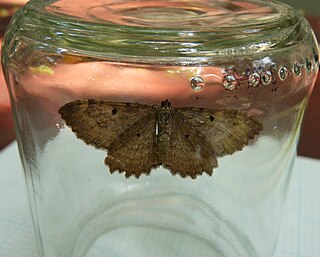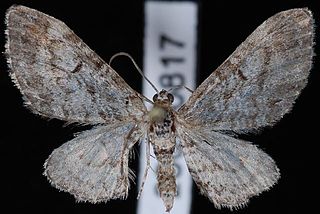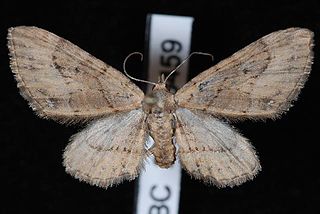
Orthonama obstipata, the gem, is a moth of the family Geometridae. The species was first described by Johan Christian Fabricius in 1794. It is common in continental Europe and adjacent lands, though in the northeast, its range does not significantly extend beyond the Baltic region and it is absent from northern Russia. This well-flying species is somewhat prone to vagrancy and able to cross considerable distances of open sea; it can thus be regularly found on the British Isles and even on Iceland.

Coryphista is a monotypic moth genus in the family Geometridae erected by George Duryea Hulst in 1896. The genus may be considered to be a synonym of Rheumaptera. Its only species, Coryphista meadii, the barberry geometer moth or barberry looper, was first described by Alpheus Spring Packard in 1874. It is found in the United States and southern Canada.
Nasusina is a genus of moths in the family Geometridae.

Spodolepis substriataria is a moth of the family Geometridae first described by George Duryea Hulst in 1896. It is found from Alaska to Nova Scotia, south in the east to New Jersey and in the west to California.
Tetracis formosa is a moth of the family Geometridae first described by George Duryea Hulst in 1896. It is found in North America from Colorado, eastern Utah and eastern Wyoming west to California and north to southern British Columbia and southern Alberta at elevations between 870 and 2,320 meters.

Hesperumia latipennis is a moth of the family Geometridae first described by George Duryea Hulst in 1896. It is found in western North America from British Columbia south to California.
Eupithecia bolterii is a moth in the family Geometridae first described by George Duryea Hulst in 1900. It is found in the US states of Arizona and Texas.
Eupithecia nimbosa is a moth in the family Geometridae first described by George Duryea Hulst in 1896. It is widespread in the Rocky Mountains, from Arizona to the Canada–US border.

Eupithecia stellata is a moth in the family Geometridae first described by George Duryea Hulst in 1896. It is found in North America from central Manitoba to northern Alberta and south to California and Mexico.
Eupithecia flavigutta is a moth in the family Geometridae first described by George Duryea Hulst in 1896. It is found in the United States in Colorado and montane forest areas in eastern Arizona and south-western New Mexico.

Eupithecia graefi, or Graef's pug, is a moth in the family Geometridae. The species was first described by George Duryea Hulst in 1896. It is found in North America from south-western Alberta west to Vancouver Island, north to Alaska and south to California. The habitat consists of wooded areas.

Eupithecia unicolor is a moth in the family Geometridae. It is found from British Columbia south to California.

Eupithecia misturata is a moth in the family Geometridae first described by George Duryea Hulst in 1896. It is widely distributed in western North America.
Eupithecia bivittata is a moth in the family Geometridae first described by George Duryea Hulst in 1896. It is found in coastal central California, United States.

Eupithecia coloradensis is a moth in the family Geometridae first described by George Duryea Hulst in 1896. It is found in North America from western Quebec and western Ontario south to North Carolina, west to New Mexico, Arizona, Colorado and south-eastern Alberta.
Eupithecia cretata is a moth in the family Geometridae first described by George Duryea Hulst in 1896. It is found in the US state of Colorado.
Eupithecia implorata is a moth in the family Geometridae first described by George Duryea Hulst in 1896. It is found in the US states of California and Arizona.
Eupithecia cestata is a moth in the family Geometridae first described by George Duryea Hulst in 1896. It is found in the US state of California.
Nasusina minuta is a moth in the family Geometridae first described by George Duryea Hulst in 1896. It is found in the United States in the desert regions of southern California, western Arizona and Nevada.
Prorella desperata is a moth in the family Geometridae first described by George Duryea Hulst in 1896. It is found in the US states of Arizona and Texas.








